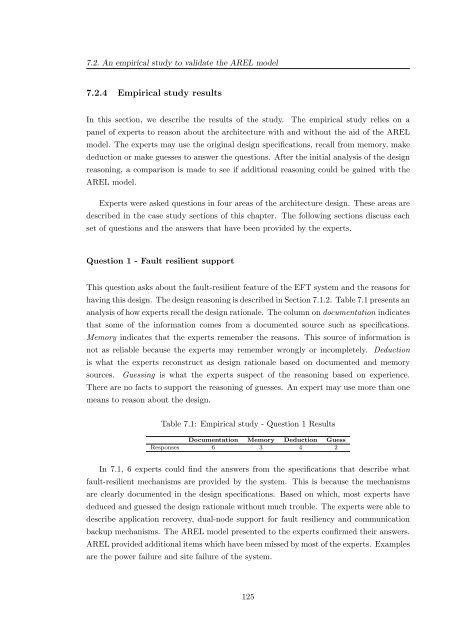A Rationale-based Model for Architecture Design Reasoning
A Rationale-based Model for Architecture Design Reasoning
A Rationale-based Model for Architecture Design Reasoning
Create successful ePaper yourself
Turn your PDF publications into a flip-book with our unique Google optimized e-Paper software.
7.2. An empirical study to validate the AREL model<br />
7.2.4 Empirical study results<br />
In this section, we describe the results of the study. The empirical study relies on a<br />
panel of experts to reason about the architecture with and without the aid of the AREL<br />
model. The experts may use the original design specifications, recall from memory, make<br />
deduction or make guesses to answer the questions. After the initial analysis of the design<br />
reasoning, a comparison is made to see if additional reasoning could be gained with the<br />
AREL model.<br />
Experts were asked questions in four areas of the architecture design. These areas are<br />
described in the case study sections of this chapter. The following sections discuss each<br />
set of questions and the answers that have been provided by the experts.<br />
Question 1 - Fault resilient support<br />
This question asks about the fault-resilient feature of the EFT system and the reasons <strong>for</strong><br />
having this design. The design reasoning is described in Section 7.1.2. Table 7.1 presents an<br />
analysis of how experts recall the design rationale. The column on documentation indicates<br />
that some of the in<strong>for</strong>mation comes from a documented source such as specifications.<br />
Memory indicates that the experts remember the reasons. This source of in<strong>for</strong>mation is<br />
not as reliable because the experts may remember wrongly or incompletely. Deduction<br />
is what the experts reconstruct as design rationale <strong>based</strong> on documented and memory<br />
sources. Guessing is what the experts suspect of the reasoning <strong>based</strong> on experience.<br />
There are no facts to support the reasoning of guesses. An expert may use more than one<br />
means to reason about the design.<br />
Table 7.1: Empirical study - Question 1 Results<br />
Documentation Memory Deduction Guess<br />
Responses 6 3 4 2<br />
In 7.1, 6 experts could find the answers from the specifications that describe what<br />
fault-resilient mechanisms are provided by the system. This is because the mechanisms<br />
are clearly documented in the design specifications. Based on which, most experts have<br />
deduced and guessed the design rationale without much trouble. The experts were able to<br />
describe application recovery, dual-node support <strong>for</strong> fault resiliency and communication<br />
backup mechanisms. The AREL model presented to the experts confirmed their answers.<br />
AREL provided additional items which have been missed by most of the experts. Examples<br />
are the power failure and site failure of the system.<br />
125
















